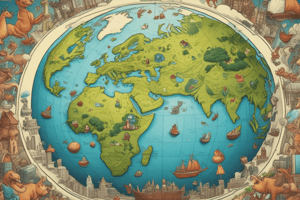Podcast
Questions and Answers
What is the main characteristic of economic globalization?
What is the main characteristic of economic globalization?
- Isolated economies with limited international trade.
- Increasing integration of economies around the world. (correct)
- Complete independence of national economies.
- Decline of cross-border movement of goods.
What was a significant outcome of the outbreak of World War 1 on the monetary system?
What was a significant outcome of the outbreak of World War 1 on the monetary system?
- The introduction of cryptocurrencies.
- The end of the classical gold standard. (correct)
- The expansion of the gold standard.
- A shift towards fiat currencies globally.
Which monetary system links the value of a country's currency directly to gold?
Which monetary system links the value of a country's currency directly to gold?
- Bretton Woods system.
- Fiat currency system.
- Gold standard. (correct)
- European Monetary System.
What institution resulted from the Uruguay Round of trade negotiations?
What institution resulted from the Uruguay Round of trade negotiations?
What was one of the strengths of the gold standard system?
What was one of the strengths of the gold standard system?
How did the European Monetary System (EMS) arise?
How did the European Monetary System (EMS) arise?
What was a notable achievement of the first ten years of the European Economic and Monetary Union (EMU)?
What was a notable achievement of the first ten years of the European Economic and Monetary Union (EMU)?
What was one of the goals of the United Nations Conference on Trade and Development (UNCTAD)?
What was one of the goals of the United Nations Conference on Trade and Development (UNCTAD)?
What does economic globalization primarily result from?
What does economic globalization primarily result from?
Which aspect is NOT included in the definition of economic globalization?
Which aspect is NOT included in the definition of economic globalization?
What led to the establishment of the European Monetary System in 1979?
What led to the establishment of the European Monetary System in 1979?
What was a significant impact of the gold standard on international trade?
What was a significant impact of the gold standard on international trade?
Which of the following is a characteristic of the European Economic and Monetary Union (EMU) during its first decade?
Which of the following is a characteristic of the European Economic and Monetary Union (EMU) during its first decade?
How is the gold standard defined?
How is the gold standard defined?
What was an effect of the Uruguay Round trade negotiations?
What was an effect of the Uruguay Round trade negotiations?
What characterized the International Monetary Systems (IMS)?
What characterized the International Monetary Systems (IMS)?
Which event marked the end of the classical gold standard?
Which event marked the end of the classical gold standard?
What was a main objective of the UNCTAD?
What was a main objective of the UNCTAD?
Flashcards are hidden until you start studying
Study Notes
Economic Globalization
- Historical process driven by human innovation and technological advances.
- Characterized by the growing integration of global economies.
- Involves the movement of goods, services, capital, labor, and technology across borders.
International Monetary Systems
- Comprises rules, customs, instruments, facilities, and organizations for international payments.
The Gold Standard
- Originated in the early 19th century with the UK's adoption of gold monometallism in 1821.
- Functioned as a monetary system linking currency value to gold.
- Countries committed to convert paper money into a fixed amount of gold.
- Affected trade balance positively until World War I, which led to its decline.
European Monetary Integration
- The collapse of the Bretton Woods System pressured the European Economic Community (EEC) to establish the European Monetary System in 1979.
- The initial decade of the Economic and Monetary Union (EMU) saw increased trade and capital flows, economic integration, and restoration of macroeconomic stability.
- The euro emerged as the second most widely used reserve currency during this period.
Multilateralism: From GATT to WTO
- The Uruguay Round of trade negotiations culminated in the formation of the World Trade Organization (WTO), marking a significant evolution in international trade institutions.
Developing Countries and International Trade
- The United Nations Conference on Trade and Development (UNCTAD) aims to enhance trade and cooperation between developing and developed nations.
Economic Globalization
- Historical process driven by human innovation and technological progress.
- Increasing integration of global economies through the movement of goods, services, capital, labor, and technology across borders.
International Monetary Systems
- Defined as rules, customs, instruments, facilities, and organizations for international payments.
- Facilitates global economic interactions and trade.
The Gold Standard
- Originated in the early 19th century with the UK adopting gold monometallism in 1821.
- Linked the value of currency directly to gold, enabling countries to convert paper money into a fixed amount of gold.
- Known for creating trade balance stability.
- The classical gold standard was disrupted by World War I, marking its end.
European Monetary Integration
- The collapse of the Bretton Woods System pressured the European Economic Community (EEC).
- Led to the establishment of the European Monetary System in 1979 as a regional monetary regime.
- The first decade of the European Economic and Monetary Union (EMU) saw increased trade, capital transactions, and restored macroeconomic stability, making the euro the second most widely used reserve currency.
Multilateralism: From the GATT to the WTO
- The Uruguay Round of trade negotiations resulted in the establishment of the World Trade Organization (WTO), marking a significant step in international trade governance.
Developing Countries and International Trade
- The United Nations Conference on Trade and Development (UNCTAD) focuses on promoting trade and cooperation between developing and developed nations.
Studying That Suits You
Use AI to generate personalized quizzes and flashcards to suit your learning preferences.




